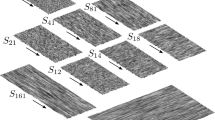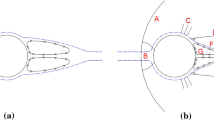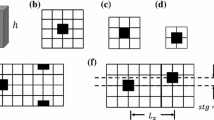Abstract
Effects of three-dimensional (3-D) distributed roughness elements on the flow characteristics within a cavity are investigated using a series of high-fidelity eddy-resolving simulations. The cavity flows generate undesirable low-frequency pressure fluctuations due to the vortex impingement over the trailing edge of the cavity. We explore the possibility of employing distributed hemispherical roughness elements as a passive flow control strategy towards suppressing these pressure fluctuations. A rectangular cavity with a length to depth ratio, L/D, of 3 is considered. Simulations are carried out at a Mach number of 0.2 and Reynolds numbers of 7000 and 19300, based on the free-stream velocity and the depth of the cavity. The effect of sparsely and densely packed roughness elements on the stability of shear layer separating from the cavity are brought out. Pre-transitional fluctuations generated by the roughness elements (a) resulted in transitional/turbulent flow at the cavity leading edge for low/high Reynolds numbers (b) promoted an earlier breakdown of the large-scale coherent structures in the shear layer (c) are beneficial in decreasing the ‘cavity tones’ and the associated sound pressure levels (SPL) by 5-13 dB. Reduction in SPL is observed to be prominent at higher Reynolds numbers and with dense spacing between the roughness elements. At low Reynolds numbers, the benefit obtained by suppressing the ‘cavity tones’ can be eclipsed with an increase in the broadband noise.












Similar content being viewed by others
Notes
Spreading rate is typically defined as \(d\delta _w/dx\), where \(\delta _w\) is the vorticity thickness
References
Acarlar, M., Smith, C.: A study of hairpin vortices in a laminar boundary layer. part 1. hairpin vortices generated by a hemisphere protuberance. J. Fluid Mech. 175, 1–41 (1987)
Achu, S., Vadlamani, N.R.: Entropically damped artificial compressibility solver using higher order finite difference schemes on curvilinear and deforming meshes. In: AIAA Scitech 2021 Forum, p. 0634 (2021)
Aylı, E., Yılmaz, İ., Selin, A.: Numerical analysis of supersonic cavity flow. In: 6th International Conference on Thermal Engineering Theory and Applications (2012)
Baysal, O., Yen, G.-W., Fouladi, K.: Navier-stokes computations of cavity aeroacoustics with suppression devices (1994)
Bres, G.A.: Numerical simulations of three-dimensional instabilities in cavity flows. PhD thesis (2007)
Colonius, T., Basu, A., Rowley, C.: Numerical investigation of the flow past a cavity. In: 5th AIAA/CEAS Aeroacoustics conference and exhibit, p. 1912 (1999)
Erbig, L., Maihöfer, M.: A hybrid rans/les for automotive gap noise simulations. In: 25th AIAA/CEAS Aeroacoustics Conference, p. 2445 (2019)
Fujiwara, K., Sriram, R., Kontis, K.: Experimental investigations on the sharp leading-edge separation over a flat plate at zero incidence using particle image velocimetry. Exp. Fluids 61(9), 1–21 (2020)
Gaitonde, D.V., Visbal, M.R.: High-order schemes for navier-stokes equations: algorithm and implementation into fdl3di. Technical report, Air Force Research Lab Wright-Patterson AFB OH Air Vehicles Directorate (1998)
Nampelly, G., Sivaramakrishnan Malathi, A., Vadlamani, N.R., Rengarajan, S., Kontis, K.: Eddy resolving simulations of shear layer instabilities in open cavity flows. In: Proceedings of the 8th International and 47th National conference on fluid mechanics and Fluid Power (FMFP) (2020)
Gloerfelt, X., Bailly, C., Juvé, D.: Direct computation of the noise radiated by a subsonic cavity flow and application of integral methods. J. sound vib. 266(1), 119–146 (2003)
Heller, H., Bliss, D.: The physical mechanism of flow-induced pressure fluctuations in cavities and concepts for their suppression. In: 2nd Aeroacoustics conference, p. 491 (1975)
Jackson, T.R., Haggerty, R., Apte, S.V., O’Connor, B.L.: A mean residence time relationship for lateral cavities in gravel-bed rivers and streams: incorporating streambed roughness and cavity shape. Water resour. res. 49(6), 3642–3650 (2013)
Jeong, J., Hussain, F.: On the identification of a vortex. J. fluid mech. 285, 69–94 (1995)
Klebanoff, P., Cleveland, W., Tidstrom, K.: On the evolution of a turbulent boundary layer induced by a three-dimensional roughness element. J. Fluid Mech. 237, 101–187 (1992)
Krist, S.L.: CFL3D User’s Manual (version 5.0). National aeronautics and space administration, Langley research center (1998)
Larchevêque, L., Sagaut, P., Lê, T.-H., Comte, P.: Large-eddy simulation of a compressible flow in a three-dimensional open cavity at high reynolds number. J. Fluid Mech. 516, 265–301 (2004)
Lin, K.-C., Jackson, K., Behdadnia, R., Jackson, T.A., Ma, F., Yang, V.: Acoustic characterization of an ethylene-fueled scramjet combustor with a cavity flameholder. J. Propuls. Power 26(6), 1161–1170 (2010)
Lin, Y., Vadlamani, R., Savill, M., Tucker, P.: Wall-resolved large eddy simulation for aeroengine aeroacoustic investigation. Aeronautical J. 121(1242), 1032–1050 (2017)
Lo, K.H., Kontis, K.: Flow around an articulated lorry model. Exp. Therm. Fluid Sci. 82, 58–74 (2017)
Ma, Y., Cui, J., Vadlamani, N.R., Tucker, P.: Effect of fan on inlet distortion: mixed-fidelity approach. AIAA j 56(6), 2350–2360 (2018)
Martin, R., Soria, M., Lehmkuhl, O., Gorobets, A., Duben, A.: Noise radiated by an open cavity at low mach number: Effect of the cavity oscillation mode. Inter. J. Aeroacoustics 18(6–7), 647–668 (2019)
Matsuura, K., Kato, C.: Large-eddy simulation of compressible transitional flows in a low-pressure turbine cascade. AIAA j. 45(2), 442–457 (2007)
Meseguer-Garrido, F., De Vicente, J., Valero, E., Theofilis, V.: On linear instability mechanisms in incompressible open cavity flow. J. Fluid Mech. 752, 219 (2014)
Nampelly, G., Sivaramakrishnan Malathi, A., Vadlamani, N.R., Rengarajan, S., Kontis, K.: Surface roughness benefits in open cavity flows. In: AIAA SCITECH 2022 Forum, p. 0473 (2022)
Naudascher, E., Rockwell, D.: Flow-induced vibrations: an engineering guide. Dover Publications Inc. (2012)
Rao, V.N., Jefferson-Loveday, R., Tucker, P.G., Lardeau, S.: Large eddy simulations in turbines: influence of roughness and free-stream turbulence. Flow, turbulence combustion 92(1), 543–561 (2014)
Reda, D.C.: Review and synthesis of roughness-dominated transition correlations for reentry applications. J. spacecraft rockets 39(2), 161–167 (2002)
Rizzetta, D.P., Visbal, M.R.: Large-eddy simulation of supersonic cavity flowfields including flow control. AIAA j. 41(8), 1452–1462 (2003)
Rossiter, J.: Wind-tunnel experiments on the flow over rectangular cavities at subsonic and transonic speeds. Aero. Res, Counc (1964)
Rowley, C.W., Colonius, T., Basu, A.J.: On self-sustained oscillations in two-dimensional compressible flow over rectangular cavities. J. Fluid Mech. 455, 315–346 (2002)
Schlanderer, S.C., Weymouth, G.D., Sandberg, R.D.: The boundary data immersion method for compressible flows with application to aeroacoustics. J. comput. Phys. 333, 440–461 (2017)
Sivaramakrishnan Malathi, A., Nardini, M., Vaid, A., Vadlamani, N.R., Sandberg, R.D.: On the efficacy of riblets toward drag reduction of transitional and turbulent boundary layers. In: AIAA SCITECH 2022 Forum, p. 0472 (2022)
Sriram, R., de Isla, S.R., Lo, K.H., Kontis, K.: Cavity flow control using dielectric barrier discharge. In: 14th International Conference on Fluid Control, Measurements, and Visualization (FLUCOME), University of Notre Dame, Indiana, USA (2017)
Sun, Y., Taira, K., Cattafesta III, L.N., Ukeiley, L.S.: Biglobal instabilities of compressible open-cavity flows. arXiv preprint arXiv:1706.00300 (2017)
Sun, Y., Liu, Q., Cattafesta, L.N., III., Ukeiley, L.S., Taira, K.: Effects of sidewalls and leading-edge blowing on flows over long rectangular cavities. AIAA j. 57(1), 106–119 (2019)
Tani, I.: Boundary-layer transition. Annu. Rev. Fluid Mech. 1(1), 169–196 (1969)
Tracy, M.B.: Cavity unsteady-pressure measurements at subsonic and transonic speeds. NASA, Langley Research Center 3669 (1997)
Vadlamani, N., Tucker, P.: Eddy resolving simulations of intake under crosswinds. Direct and Large-Eddy Simulation XI, Springer, 523–529 (2019)
Vadlamani, N.R., Tucker, P.G., Durbin, P.: Distributed roughness effects on transitional and turbulent boundary layers. Flow Turbulence Combustion 100(3), 627–649 (2018)
Vaid, A., Vadlamani, N.R., Sivaramakrishnan Malathi, A.: Dynamics of bypass transition with roughness and pulses of free-stream turbulence. In: AIAA SCITECH 2022 Forum, p. 0453 (2022)
Vakili, A., Wolfe, R., Nagle, T., Lambert, E.: Active control of cavity aeroacoustics in high speed flows. In: 33rd Aerospace sciences meeting and exhibit, p. 678 (1995)
Visbal, M.R., Gaitonde, D.V.: High-order-accurate methods for complex unsteady subsonic flows. AIAA j. 37(10), 1231–1239 (1999)
Visbal, M.R., Gaitonde, D.V.: Very high-order spatially implicit schemes for computational acoustics on curvilinear meshes. J. Comput. Acoustics 9(04), 1259–1286 (2001)
Visbal, M.R., Gaitonde, D.V.: On the use of higher-order finite-difference schemes on curvilinear and deforming meshes. J. Comput. Phys. 181(1), 155–185 (2002)
Wang, Y., Li, S., Yang, X.: Numerical investigation of the passive control of cavity flow oscillations by a dimpled non-smooth surface. Appl. Acoustics 111, 16–24 (2016)
Ye, Q., Schrijer, F.F., Scarano, F.: Geometry effect of isolated roughness on boundary layer transition investigated by tomographic piv. Inter. J. Heat Fluid Flow 61, 31–44 (2016)
Yokoyama, H., Odawara, H., Iida, A.: Effects of freestream turbulence on cavity tone and sound source. Inter. J. Aerosp. Eng. 2016 (2016)
You, D., Wang, M., Moin, P., Mittal, R.: Large-eddy simulation analysis of mechanisms for viscous losses in a turbomachinery tip-clearance flow. J. Fluid Mech. 586, 177–204 (2007)
Acknowledgements
The authors wish to acknowledge P G Senapathy Centre, IIT Madras for the computing resources, Department of Science and Technology-Science and Engineering Research Board (DST-SERB) for funding the project and NVIDIA for generously donating Quadro P6000 and A100 GPU cards. The support and the resources provided by PARAM Sanganak under the National Supercomputing Mission, Government of India are gratefully acknowledged.
Author information
Authors and Affiliations
Corresponding author
Ethics declarations
Conflict of interest
The authors declare that they have no conflict of interest.
Rights and permissions
Springer Nature or its licensor holds exclusive rights to this article under a publishing agreement with the author(s) or other rightsholder(s); author self-archiving of the accepted manuscript version of this article is solely governed by the terms of such publishing agreement and applicable law.
About this article
Cite this article
Nampelly, G., Malathi, A.S., Vaid, A. et al. Surface Roughness Effects on Cavity Flows. Flow Turbulence Combust 109, 1215–1239 (2022). https://doi.org/10.1007/s10494-022-00345-7
Received:
Accepted:
Published:
Issue Date:
DOI: https://doi.org/10.1007/s10494-022-00345-7




